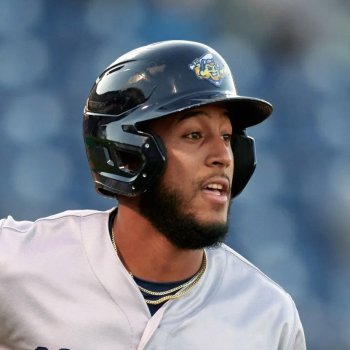The Twins' Awful, Unrepeatable 2nd Half
Twins Video
 At the All-Star break, the Twins were in decent shape, just 6 games under .500 and on pace to finish with a win total in the mid-70s that would have demonstrated clear progress in their rebuilding efforts. But they faltered out of the gate in the 2nd half, dropping 9 of 13 to finish July (the first 10 of which were at home). Now 11 under .500 and 11 games out of 1st place, it was time to sell the veterans and turn to youth. Out with Kendrys Morales, Josh Willingham, Kevin Correia and Matt Guerrier, in with Kennys Vargas, Jordan Schafer, Trevor May, and Ryan Pressly.
At the All-Star break, the Twins were in decent shape, just 6 games under .500 and on pace to finish with a win total in the mid-70s that would have demonstrated clear progress in their rebuilding efforts. But they faltered out of the gate in the 2nd half, dropping 9 of 13 to finish July (the first 10 of which were at home). Now 11 under .500 and 11 games out of 1st place, it was time to sell the veterans and turn to youth. Out with Kendrys Morales, Josh Willingham, Kevin Correia and Matt Guerrier, in with Kennys Vargas, Jordan Schafer, Trevor May, and Ryan Pressly.
The newly reconstituted roster quickly descended into the most wretched stretch of the season, going 14-27 from the beginning of August through mid-September, outraging the fanbase, and promptly costing Gardy his job at season’s end. But I’m OK with beginning 2015 with about 80% of the players who were on the field for those last 2 months, and you should be, too! Here’s why:
The Offense was better
After a surprisingly high-scoring April (fueled by a sky-high OBP) the pendulum swung the other way in May. The average of those 2 months corresponded pretty well with the .690-ish team OPS the Twins put up in June & July. Through the first 2/3 of the season, the offense averaged a tick over 4 R/G. But in the final 55 games, they exploded for 280 R, increasing the per-game average by over a run. Over a full season, 90% of that scoring rate would have produced the #4 offense in baseball. And 90% of the extremely good BABIP the Twins put up over those final 2 months would be more or less the league average.
There will certainly be regression from some players (most notable Santana). But there were several positions that provided below average production in the final months, too. Not only did Suzuki’s All-Star 1st half not carry over, but his second half results were beneath his modest career averages. Mauer, though much better than he was in the spring, was still well short of his career average OPS of .860 or so. Dozier continued to get on base, but didn’t sustain the HR and SB pace he established over the early part of the season. (That the baserunners accumulated nearly as many SB (49) in 68 2nd half games as they did in 94 1st half games (50) with little contribution from Dozier is an indication of how much more baserunning can be a weapon for the Twins next year.)
All told, when I look at the rates the hitters put up in August & September, I’d expect a lot less (upwards of .100 OPS) from Santana, a bit less from Plouffe, Schafer, & Escobar, about the same from Arcia & Vargas, a bit more from Dozier & Hicks, and a quite a bit more (upwards of .050 OPS) from Mauer & the catchers (especially with Pinto getting the PAs that were going to Fryer). A repeat of 2014’s 714 RS seems like a pretty safe floor for this offense.
The Starting Pitching was better
Seriously:
1st Half: 5.8 K/9, 2.4 BB/9, 8.7% HR/FB, .319 BABIP, 4.86 ERA, 4.21 xFIP
2nd Half: 7.2 K/9, 2.4 BB/9 9.8% HR/FB, .333 BABIP, 5.35 ERA, 3.89 xFIP
And the prospects for 2015 are even better than that. 25 rather horrendous 2nd half starts were made by pitchers who will not be starting games for the Twins next year: Kevin Correia (4 GS, 4.79 xFIP), Anthony Swarzak (4, 4.86), Yohan Pino (6, 4.02 – he deserved better), Kris Johnson (1, 4.57), Logan Darnell (4, 3.38 – but so many HRs), weirdly awful Tommy Milone (5, 5.27) and MLB debut Trevor May (1, 16.10(!)). It’s possible that Darnell could see some spot starts next year, though I’d expect him to be well down the depth chart. Whatever was going on with Milone in August, it was unprecedented in nearly 80 prior career GS. Should he be asked to start in 2015 I’d expect to see that guy (4.22 xFIP) rather than the doppelganger who made such a poor 1st impression in MN.
The Twins quietly finished the season with an effective front 4: Phil Hughes (13, 3.20), Kyle Gibson (13, 3.76), Ricky Nolasco (9, 3.71) and not-making-his-MLB-debut May (8, 3.77). Each of those xFIPs was league average or better, and Hughes can afford a ton of regression in his walk rate before he would fall below that standard. Gibson’s growth should be expected of a high-pedigree prospect with 25+ career GS under his belt, and post-DL Nolasco was essentially the guy they signed to the biggest FA contract in team history.
That the starters’ ERA for the most part drastically overshot their xFIP is the result of a complex cocktail whose ingredients include bad luck on balls in play, bad defense, bad pitching with men on base, and bad work from a bullpen that failed to strand inherited runners. Of those factors, the pitching with men on is the only thing they can really control, and should be a matter of focus for them as they prepare for next season.
The Bullpen sucked!
As I alluded to above, the bullpen didn’t do the starters any favors. They couldn’t strand runners, couldn’t protect leads, couldn’t consistently get the outs they were brought in to get. They were last in the Majors in 2nd half K/9 by a large margin, and as a group were below replacement level. I believe a league average relief squad would have netted the Twins at least 5 additional wins in 2014, and lessened a lot of the hysteria related to 4 straight 90+ loss seasons.
So why am I OK with that performance? Because it’s a failure that is very unlikely to be repeated. Relievers are the most fungible asset in baseball, as demonstrated by the Twins scooping up Casey Fien and Jared Burton off the scrap heap before the 2012 season. Even elite FA relievers with extensive track records cost much less per season and demand shorter-term contracts than starters and position players. The Twins have already declined Burton’s services for 2015, and I expect them to pass on Brian Duensing and Anthony Swarzak, too. That trio combined to allow 21 inherited runners to score just in the awful ¼ season from August 1st to mid-September. Replacing them with average or better relievers will make a huge difference.
Some of those replacements might already be under team control. AAA Rochester’s bullpen was excellent all season. Michael Tonkin and Aaron Thompson were pretty effective in their September call-ups, and Lester Oliveros completed the season with 5 straight scoreless appearances totaling 5.2 IP, 5 K, 1 H and 1 BB. And, close behind them, the upper minors are loaded with high-velocity arms that could find their way onto the team by the 2nd half of 2015: Nick Burdi, Zach Jones, Jake Reed… The days of the Twins bringing up the rear in bullpen K% may already be behind us.
Better Luck Next Year
The Twins allowed a very poor BABIP for the 2nd consecutive year in 2014, and it will take some improvements to the defense (especially the OF) to get that back into the average range. But that OF defense was similarly bad in both 2013 & 2014, and yet the BABIP was a few points worse last year. All of the negative difference came in the 2nd half, when the pitchers suffered a .328 BABIP despite having 2 of Schafer, Santana and Hicks in the OF most of the time. Certainly, there was some very bad pitching after the All-Star break. There was also a lot of OK to good pitching with some very bad luck.
Look back through some of the game logs in which the Twins allowed huge crooked numbers. In many cases those innings were prolonged by one or more IF or bunt hits. I can never fault a pitcher for giving up a hit because he induced a batter to hit a GB too slowly, or in the perfect spot. It’s maddening, but those results are fairly random, and the wheel tends to swing back the other way as time goes on. The group we saw in August & September, given average luck on their balls in play, might have erased their 17 run deficit and finished with an even or better run differential over those 2 months.
And there’s one other wild swing of luck we need to consider – when the runs were scored. Over the 1st 4 months of the season, the Twins’ record corresponded perfectly with their Pythagorean record – the estimated winning % derived from the total scores of their games. The total scores they produced after the trade deadline should have been good for a 26-29 record, but instead came up well short at 22-33. Isolate it further by separating the final 14 games of the season and you find that the Twins’ entire shortfall in expected wins occurred within that disastrous 41-game stretch from August 1st-September 13th.
The most obvious place this shows up is in games decided by 1 run. Within this late-summer stretch, the Twins were 1-8 in 1-run games. In the other ¾ of the season, they were 20-16. Had they continued to win those closest games at the same rate as they had been doing, they would have gone 5-4 in those 9 games. There’s your 4 extra wins. Losing very close games is not an unexpected byproduct of having everybody in the bullpen fail at the same time.
Focus on the Finish
A lot of people had understandably stopped paying attention to the Twins by mid-September, when things finally stabilized. The offense continued to score about 5 R/G. The pitching - excepting 13 dreadful spot start IP from Swarzak – put up a 3.70 ERA and 1.18 WHIP. Half of those 14 games came against a very productive Tigers lineup that was fighting for playoff position.
We saw that some of these guys can be pretty good. May had 2 quality starts and a 20/3 K/BB ratio. Nolasco also went 2/3 in quality starts with a 16/4 K/BB ratio. Vargas broke out of his early-September slump by re-adding walks to his game – 8 BB in the final week, where he’d had just 4 in the previous 7! Dozier rediscovered his power, Mauer got his average back over .300.
For me, much of the fans’ sour impression of the Twins comes from the terrible results of that awful late-summer run. There was plenty of bad baseball there, to be sure. There was also a lot of absurdly bad luck, and several performances that are unlikely to be repeated – whether because of changing personnel, better health, or the maturation of young players. When you think about what the Twins need to do to improve in 2015, remember those caveats, and build from the final days of September instead of the first days of August.
- nytwinsfan, Willihammer, Platoon and 1 other
-
 4
4






2 Comments
Recommended Comments